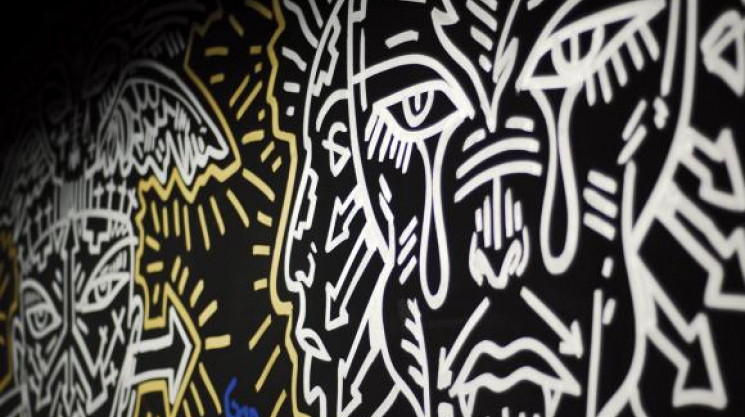
Tue, 12/10/2013 - 16:23 by Natasha Neale
Our regular arts and culture contributor, Karyn Gray, speaks to the original street art king, ZÏLON LAZER, about his oft under-publicized and under-appreciated trailblazing.
A little while ago, I went to the premiere of Pat O’Connor’s documentary Making a Name, a comprehensive and in-depth look at the Montreal graffiti scene, with footage of, and interviews with a veritable who’s who of giants in the graffiti world over the past couple of decades. It didn’t come as much of a surprise to me that Zïlon Lazer was the person chosen to kick off the line-up of interviews in the film. I mean, he was the first. In Montreal, he’s widely recognized as a pioneer, if not the pioneer, of street art. Writers and artists can love him or hate him, but either way, that trail they’re walking along - the one through alleys, or stores, or galleries - was blazed by Zïlon.
A self-taught artist, inspired by early Jack Kirby comic books from Marvel and DC, he was drawing from his figurative day one. His first urban pieces started to pop up in the 1970s, in the suburbs where he was living with his parents – mainly schoolyards and walls of park buildings. According to Zïlon, his parents never believed in his talent and tried many times to discourage him from pursuing his art, even physically beating him, but they were unsuccessful. “I was a hard head from an early age,” he remarks. In time he started to export his signature faces, drawn with black marker or black spray paint, from the suburbs to the city, in nightclubs and urban spaces, and eventually he started to work on canvasses.
In the early eighties, he became part of monthly events called “Live Painting Nights” at the infamous underground club Foufounes Électriques, and soon after, he was discovered by the Holder Brothers – future owners of a new concept club to be called The Business Bar. The concept was that of an art bar, where every season they would have different artists, of different mediums, transform the club interior. Zïlon was invited to create the second visual installation in 1987: a wall-to-wall, floor to ceiling spray-painted Zïlon universe he called "ZÏLON means BU$INE$$!!!" A huge success, the installation led to interviews with an array of media–magazines, television and radio–and his reputation as the “bad boy of art” was formed.
“The beginnings of graffiti in Montreal were a slim art form,” Zïlon muses. “Some scribbles here and there, and the classic poorly drawn characters with penises and boobs, and stupid comments written around them. I was one to pioneer my style, an aesthetic minimal stroke on the walls of an androgynous face. It became my trademark touch in a bleak, grey, downtown Montreal filled with punks and new wavers. It was a very creative moment, the eighties. New kids on the block started to come up with more expressive and energized urban artworks here and there. Most of them I called ‘my children,’” he laughs. “Downtown Montreal was eventually covered with stenciled art, spray-painted and marker beauties. I became sort of a ‘leader of the pack,’ loved by some and hated by some, but at the end of the day, I did my work alone. I'm a loner as a person, and I never tried to connect with some of the early groups because there were none I really liked.”
At the same time in New York City, street art was exploding at the hands of artists like Keith Haring, Basquiat and Futura 2000, yet in Montreal, Zïlon was pressing on, hitting road block after road block. “I was doing my stuff at the same time as a ‘revolution’ in New York, with some fabulous artists,” recalls Lazer. “Their art was being shown to the world. In Montreal, we didn’t have the tools or the adequate media and events to effectively show our artists to the world, but some new magazines and events are trying now. If I could’ve been over there during those golden years of urban art, and photographed with Warhol or Grace Jones, I would be in a big gallery showing my art around the world. I’m sure of that. But I was fighting to pay my rent, eating Kraft Dinner, and collecting welfare. I learned at a very young age that, as far as [highbrow] galleries were concerned, with their select little group of buyers, I was facing a load of crappy politics. So I retaliated by showing my art on the streets, armed with my stolen black markers and spray paint. I used the streets as my own personal gallery. In the eighties, we didn’t have graffiti-specialized galleries like we have today. I’ve had to show my stuff in crappy art spaces with badly painted flowers, with spatulas, and winter landscapes with snow bunnies,” he laughs. “In Quebec, we’re not very inclined and don’t have the guts to show new stuff. We only show stuff coming out of art schools by so-called diploma holding conceptual art students, in some pompous galleries owned by crass people. Well, not all of them, of course…I’m just talking about those rich bitches with a load of cash, not knowing what to do with it, and hiding it from the income tax people.”
After years, decades, filled with a mix of obstacles and triumphs, criticism and appreciation, Zïlon Lazer undoubtedly deserves the title of “street art pioneer”. Armed with a hard head and thick skin, Zïlon is ready for his next adventure – an art collaboration with Givenchy in Paris in October. “Today, the graffiti scene in Montreal is flourishing and popping everywhere - murals, old abandoned store fronts transformed with fabulous colours and dynamic characters. My preferred place to showcase my art is still the streets, because there's no censorship and stupid gallery morons telling you what to do in order for them to make more money. The streets are wild and beautiful.”




Add comment